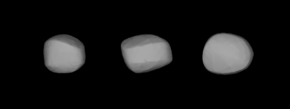 A three-dimensional model of 69 Hesperia based on its light curve. A three-dimensional model of 69 Hesperia based on its light curve. | |
| Discovery | |
|---|---|
| Discovered by | G. Schiaparelli |
| Discovery date | April 29, 1861 |
| Designations | |
| MPC designation | (69) Hesperia |
| Pronunciation | /hɛˈspɪəriə/ |
| Named after | Hesperia |
| Minor planet category | Main belt |
| Adjectives | Hesperian /hɛˈspɪəriən/ |
| Orbital characteristics | |
| Epoch (absent) | |
| Aphelion | 3.471 AU (519.3 Gm) |
| Perihelion | 2.489 AU (372.3 Gm) |
| Semi-major axis | 2.980 AU (445.8 Gm) |
| Eccentricity | 0.165 |
| Orbital period (sidereal) | 1,879 days (5.14 a) |
| Inclination | 8.59° |
| Longitude of ascending node | 184.99° |
| Argument of perihelion | 288.8° |
| Physical characteristics | |
| Dimensions | 138 km (IRAS) 110 ± 15 km |
| Mass | (5.86±1.18)×10 kg |
| Mean density | 4.38±0.99 g/cm |
| Synodic rotation period | 5.655 h |
| Geometric albedo | 0.140 |
| Spectral type | M |
| Absolute magnitude (H) | 7.05 |
69 Hesperia is a large, M-type main-belt asteroid. It was discovered by the Italian astronomer Giovanni Schiaparelli on April 29, 1861 from Milan, while he was searching for the recently discovered 63 Ausonia. It was his only asteroid discovery. Schiaparelli named it Hesperia in honour of Italy (the word is a Greek term for the peninsula). The asteroid is orbiting the Sun with a period of 5.14 years, a semimajor axis of 2.980 AU, and eccentricity of 0.165. The orbital plane is inclined by an angle of 8.59° to the plane of the ecliptic.
Hesperia was observed by Arecibo radar in February 2010. Radar observations combined with lightcurve-based shape models, lead to a diameter estimate of 110 ± 15 km (68 ± 9.3 mi). The radar albedo is consistent with a high-metal M-type asteroid. In the near infrared, a weak absorption feature near a wavelength of 0.9 μm can be attributed to orthopyroxenes on the surface. A meteorite analogue of the reflectance spectra from 69 Hesperia is the Hoba ataxite.
References
- ^ "Editorial Notice" (PDF). The Minor Planet Circulars. MPC 94743-95312: 94743. 29 August 2015. Retrieved 4 September 2015.
- Noah Webster (1884) A Practical Dictionary of the English Language
- "Hesperian". Oxford English Dictionary (Online ed.). Oxford University Press. (Subscription or participating institution membership required.)
- ^ "JPL Small-Body Database Browser: 69 Hesperia" (2011-09-07 last obs). Jet Propulsion Laboratory. Retrieved 27 January 2012.
- ^ Shepard, Michael K.; Harris, Alan W.; Taylor, Patrick A.; Clark, Beth Ellen; Ockert-Bell, Maureen; Nolan, Michael C.; et al. (2011). "Radar observations of Asteroids 64 Angelina and 69 Hesperia" (PDF). Icarus. 215 (2): 547–551. arXiv:1104.4114. Bibcode:2011Icar..215..547S. doi:10.1016/j.icarus.2011.07.027.
- ^ Carry, B. (December 2012), "Density of asteroids", Planetary and Space Science, vol. 73, pp. 98–118, arXiv:1203.4336, Bibcode:2012P&SS...73...98C, doi:10.1016/j.pss.2012.03.009. See Table 1.
- De Meis, S. (2011), "A few aspects of Schiaparelli's studies", Memorie della Societa Astronomica Italiana, 82: 290, Bibcode:2011MmSAI..82..290D.
- Schmadel, Lutz D. (2003), Dictionary of Minor Planet Names, Springer Science & Business Media, p. 22, ISBN 978-3-540-00238-3.
- Hardersen, Paul S.; et al. (May 2005), "Near-IR spectral evidence for the presence of iron-poor orthopyroxenes on the surfaces of six M-type asteroids", Icarus, 175 (1): 141−158, Bibcode:2005Icar..175..141H, doi:10.1016/j.icarus.2004.10.017.
- Neeley, J. R.; et al. (August 2014), "The composition of M-type asteroids II: Synthesis of spectroscopic and radar observations", Icarus, 238: 37−50, arXiv:1407.0750, Bibcode:2014Icar..238...37N, doi:10.1016/j.icarus.2014.05.008.
External links
- Bareket Observatory Archived 15 March 2010 at the Wayback Machine (Asteroid 69 Hesperia movie - through an Earth-based telescope.) (in Hebrew)
- 69 Hesperia at AstDyS-2, Asteroids—Dynamic Site
- 69 Hesperia at the JPL Small-Body Database

| Minor planets navigator | |
|---|---|
| Small Solar System bodies | |||||||
|---|---|---|---|---|---|---|---|
| Minor planets |
| ||||||
| Comets | |||||||
| Other | |||||||